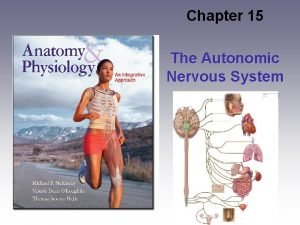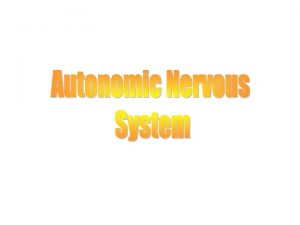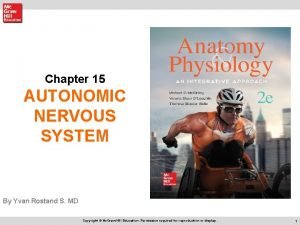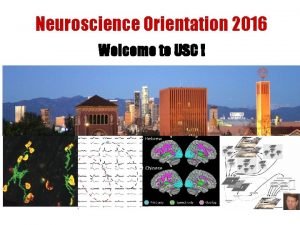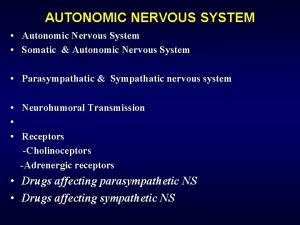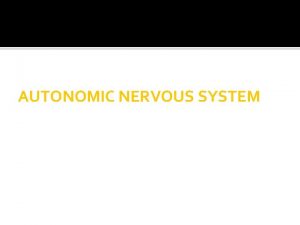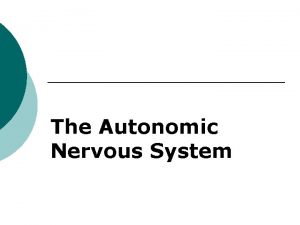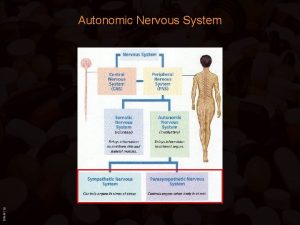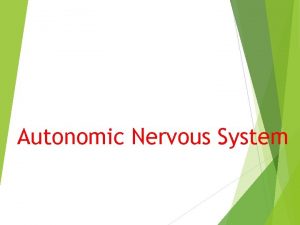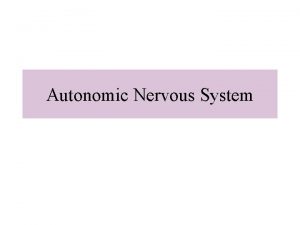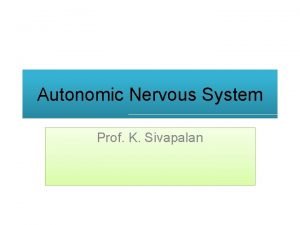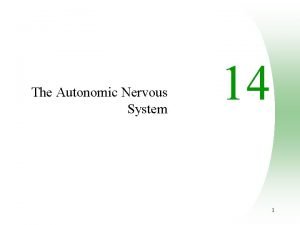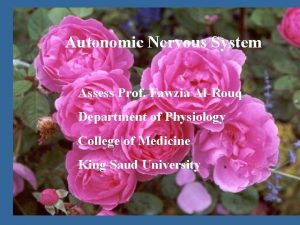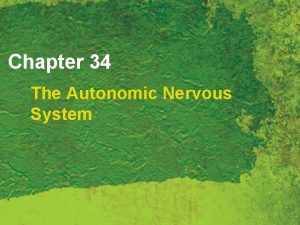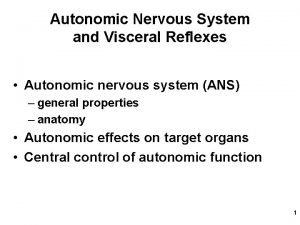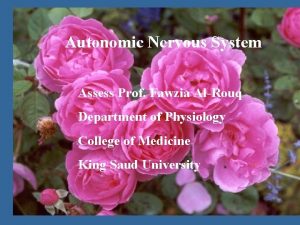Autonomic Nervous System Medical Neuroscience Dr Wiegand Autonomic





















- Slides: 21

Autonomic Nervous System Medical Neuroscience Dr. Wiegand

Autonomic Nervous System ¢ ¢ ¢ Enteric System Sympathetic Nervous System Parasympathetic Nervous System All systems have GVE and GVA components Primarily considered a two neuron chain motor system

Autonomic Nervous System Hypothalamus Reticular Formation Spinal Level Periphery Autonomic Nervous System Afferent Input (GVA) Limbic System

Skeletal vs. Smooth Muscle Motor Systems

PSNS & SNS – Similarities “B” fiber “C” fiber Nuclei Acetylcholine Spinal cord or brainstem Periphery Ganglia

PSNS & SNS – Differences ¢ SNS l l l activate body thoracolumbar (T 1 -L 2) short preganglionic/long postganglionic fibers global responses postganglionic transmitter: norepinephrine (except sweat glands – ACH) ¢ PSNS l l l prepare body for rest craniosacral (CN III, VII, IX, X & S 2 -4) long preganglionics/short postganglionic fibers discrete/local responses postganglionic transmitter: acetylcholine


Sympathetic Nervous System ¢ ¢ “Fight or Flight” system Activation l l l increases heart rate increases sweating dilates pupil inhibits GI movement closes sphincters diverts blood from skin and GI tract to skeletal muscles


Sympathetic Nervous System. Preganglionic Neuron May: 1. terminate on postganglionic neuron in the sympathetic chain ganglia 2. ascend or descend to higher or lower ganglia and terminate on postganglionic neuron in the sympathetic chain ganglia 3. pass through the sympathetic chain to prevertebral ganglia (celiac, inferior or superior mesenteric) 4. pass through the sympathetic chain ganglia to adrenal medulla

referred pain • heart – T 1 -4 • gall bladder – T 6 -8 • stomach – T 7 -8


¢ ¢ preganglionic fibers from T 1 -5 ascend postganglionic fibers from sup. cervical ganglia follow carotid a. fibers follow III and V ophthalmic innervate dilator m, levator palpebrae, sweat & lacrimal glands

Parasympathetic Nervous System ¢ prepares body for rest promotes digestion, GI peristalsis l slows heart rate l constricts pupil l empties bladder l relaxes sphincters l mediates genital erection l


Horner’s Syndrome ¢ ¢ ¢ damage to the descending fibers from the hypothalamus or the superior cervical ganglia miosis – pupillary constriction anhidrosis – lack of sweating ptosis – drooping of the eye lid enophthalmos – eye appears to sink in to the orbit

Bladder ¢ ¢ SNS – retention PSNS – voiding (micturation)

L 1 – L 2 GVE ¢ ¢ ¢ SNS input from L 1 -2 (int. urinary sphincter) PSNS input from S 24 (detrusor mm) GSE (Onuf) to ext. urinary sphincter GSA (pain, temp & pressure to T 12/L 1 & S 2 -4 GVA to S 2 -4 paracentral lobule & brainstem S 2 – S 4 GVE S 2 – S 4 GSE S 2 -4 GVA/GSA (T 12/L 1)

Autonomic Nervous System and the Bladder ¢ ¢ “UMN bladder” = “spastic bladder” = automatic reflex bladder “LMN bladder” = “flaccid bladder” = “atonic bladder” = autonomous reflex bladder


 Sympathetic nervous system def
Sympathetic nervous system def Skeletal muscle autonomic nervous system
Skeletal muscle autonomic nervous system Autonomic nervous system consists of
Autonomic nervous system consists of Somatic and autonomic nervous system
Somatic and autonomic nervous system Spinal cord dorsal and ventral roots
Spinal cord dorsal and ventral roots Autonomic nervous system
Autonomic nervous system The autonomic nervous system controls
The autonomic nervous system controls Adrenal gland sympathetic nervous system
Adrenal gland sympathetic nervous system Autonomic nervous system
Autonomic nervous system Nervous system main division
Nervous system main division What are the characteristics of nervous tissue
What are the characteristics of nervous tissue Sensory input and motor output
Sensory input and motor output Processes neuron
Processes neuron Autonomic nerveous system
Autonomic nerveous system Nervous system and digestive system
Nervous system and digestive system Endocrine system vs nervous system
Endocrine system vs nervous system Amino acid-based hormones
Amino acid-based hormones Adh function
Adh function Nature neuroscience
Nature neuroscience Usc neuroscience major
Usc neuroscience major Dynamical systems neuroscience
Dynamical systems neuroscience Acial feedback hypothesis
Acial feedback hypothesis





